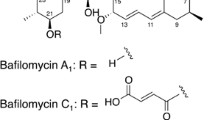Abstract
Bagremycin A and B, produced by Streptomyces sp. Tü 4128, are two antibiotics active against Gram-positive bacteria and fungi. To elucidate the biosynthetic pathway of bagremycins, two genes named bagB and bagC, were cloned and characterized from a bagremycin-producing strain. The deduced protein products of bagB and bagC show high sequence identity with aldolase and 3-dehydroquinate synthase, respectively. The bagC gene is located immediately downstream of the bagB gene and subsequent reverse transcription and polymerase chain reaction analysis revealed that bagB is co-transcribed with bagC. Inactivation of either bagB or bagC resulted in the complete abolishment of bagremycin production in fermented cultures, which suggests that these two genes are involved in the biosynthesis of bagremycins. The results from this study will allow acquisition of the entire biosynthetic cluster for bagremycins and further our understanding of the biosynthetic pathway and mechanism of action of bagremycin.




Similar content being viewed by others
Reference
Bertasso M, Holzenkämpfer M, Zeeck A, Dall'Antonia F, Fiedler HP (2001) Bagremycin A and B, novel antibiotics from Streptomyces sp. Tü 4128. J Antibiot (Tokyo) 54:730–736
Bertasso M, Holzenkämpfer M, Zeeck A, Dall'Antonia F, Fiedler HP (2004) Bagremycins are two new para-coumaric acid derived antibiotics produced by Streptomyces sp. Tü 4128. In: Rainer J, Ashok P, Günter T (eds) Biotechnological advances and applications in bioconversion of renewable raw materials. BGBF and InWEnt, Braunschweig, pp 86–91
Bierman M, Logan R, O'Brien K, Seno ET, Rao RN, Schoner BE (1992) Plasmid cloning vectors for the conjugal transfer of DNA from Escherichia coli to Streptomyces spp. Gene 116:43–49
Flett F, Mersinias V, Smith CP (1997) High efficiency intergeneric conjugal transfer of plasmid DNA from Escherichia coli to methyl DNA-restricting streptomycetes. FEMS Microbiol Lett 155:223–229
Kieser T, Bibb MJ, Buttner MJ, Chater KF, Hopwood DA (2000) Practical streptomyces genetics. John Innes Foundation, Norwich
Kim MK, Ha HS, Choi SU (2008) Conjugal transfer using the bacteriophage φC31 att/int system and properties of the attB site in Streptomyces ambofaciens. Biotechnol Lett 30:695–699
Liu Y, Whittier R (1995) Thermal asymmetric interlaced PCR: automatable amplification and sequencing of insert end fragments from P1 and YAC clones for chromosome walking. Genomics 25:674–681
Michiels A, Tucker M, Van den Ende W, Laere AV (2003) Chromosomal walking of flanking regions from short known sequences in GC-rich plant genomic DNA. Plant Mol Biol Rep 21:295–302
Morar M, White RH, Ealick SE (2007) Structure of 2-amino-3,7-dideoxy-d-threo-hept-6-ulosonic acid synthase, a catalyst in the archaeal pathway for the biosynthesis of aromatic amino acids. Biochemistry 46:10562–10571
Muth G, Farr M, Hartmann V, Wohlleben W (1995) Streptomyces ghanaensis plasmid pSG5: nucleotide sequence analysis of the self-transmissible minimal replicon and characterization of the replication mode. Plasmid 33:113–126
Negron L, Parker EJ (2011) Fluorinated substrates result in variable leakage of a reaction intermediate during catalysis by dehydroquinate synthase. Org Biomol Chem 9:2861–2867
Ngo PT, Natarajan S, Kim H, Hung HK, Kim JG, Lee BM, Ahn YJ, Kang LW (2008) Cloning, expression, crystallization and preliminary X-ray crystallographic analysis of 3-dehydroquinate synthase, Xoo1243, from Xanthomonas oryzae pv. oryzae. Acta Crystallogr Sect F Struct Biol Cryst Commun 64:1128–1131
Noguchi A, Kitamura T, Onaka H, Horinouchi S, Ohnishi Y (2010) A copper-containing oxidase catalyzes C-nitrosation in nitrosobenzamide biosynthesis. Nat Chem Biol 6:641–643
Porat I, Sieprawska-Lupa M, Teng Q, Bohanon FJ, White RH, Whitman WB (2006) Biochemical and genetic characterization of an early step in a novel pathway for the biosynthesis of aromatic amino acids and p-aminobenzoic acid in the archaeon Methanococcus maripaludis. Mol Microbiol 62:1117–1131
Suzuki H, Ohnishi Y, Furusho Y, Sakuda S, Horinouchi S (2006) Novel benzene ring biosynthesis from C(3) and C(4) primary metabolites by two enzymes. J Biol Chem 281:36944–36951
Wu J, Howe DL, Woodard RW (2003) Thermotoga maritima 3-deoxy-d-arabino-heptulosonate 7-phosphate (DAHP) synthase. J Biol Chem 278:27525
Acknowledgments
We are particularly thankful to Prof. Hans-Peter Fiedler for providing strain Streptomyces sp. Tü 4128 and bagremycin samples. We also thank Prof. Changsheng Zhang for sharing strain Escherichia coli ET12567/pUZ8002 and plasmid pSET152 with us. We thank Dr. Tamara A. Bowman (Center for Pharmacogenomics, Washington University in St. Louis School of Medicine) for her careful language edit of this manuscript.
Author information
Authors and Affiliations
Corresponding authors
Electronic supplementary material
Below is the link to the electronic supplementary material.
ESM 1
(DOC 3491 kb)
Rights and permissions
About this article
Cite this article
Zhu, Y., Xu, D., Liao, S. et al. Cloning and characterization of bagB and bagC, two co-transcribed genes involved in bagremycin biosynthesis in Streptomyces sp. Tü 4128. Ann Microbiol 63, 167–172 (2013). https://doi.org/10.1007/s13213-012-0457-0
Received:
Accepted:
Published:
Issue Date:
DOI: https://doi.org/10.1007/s13213-012-0457-0




